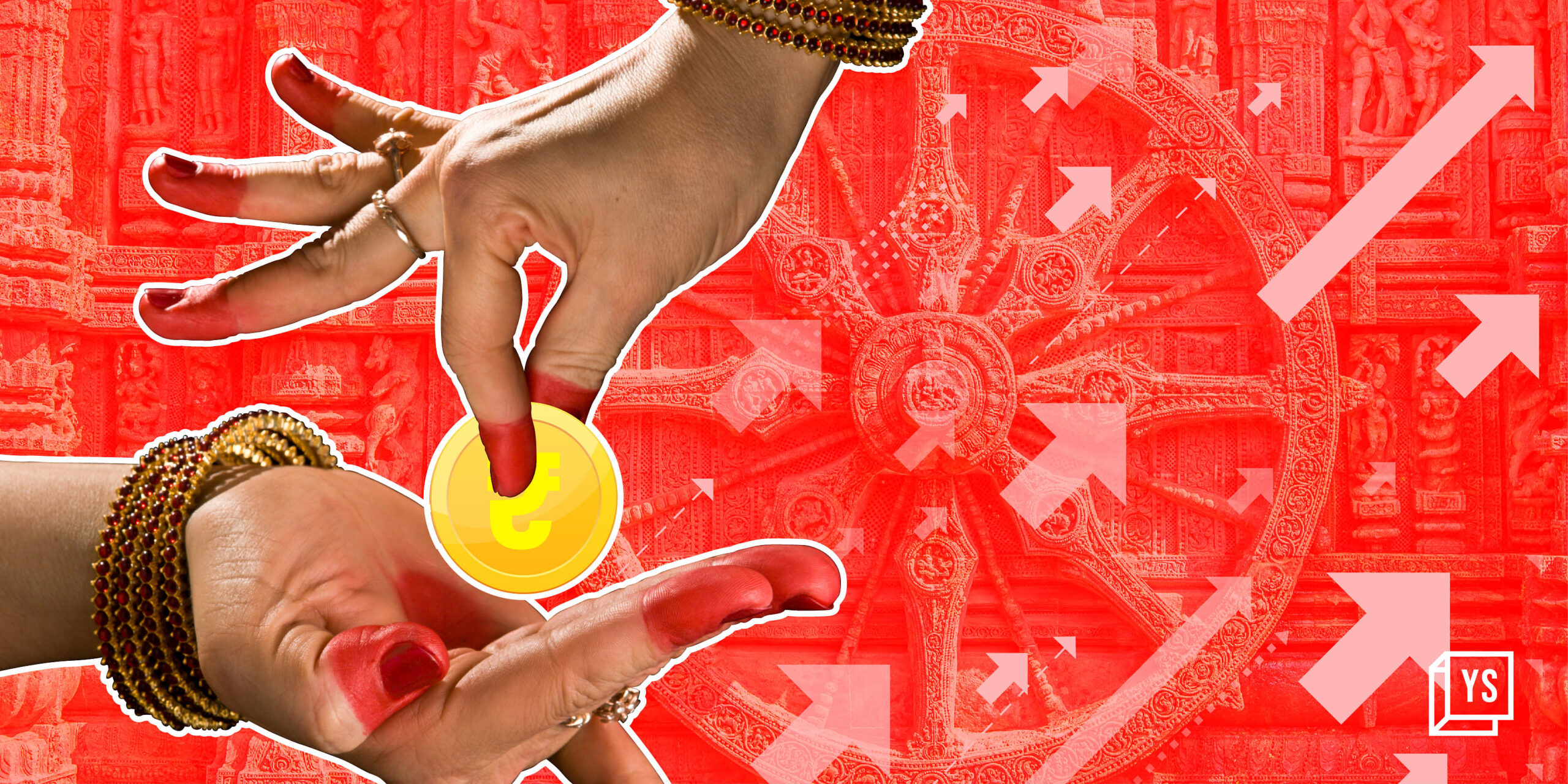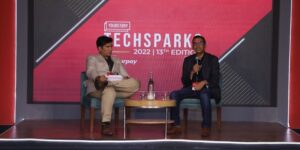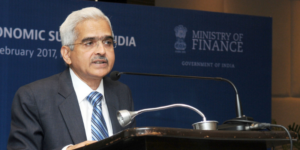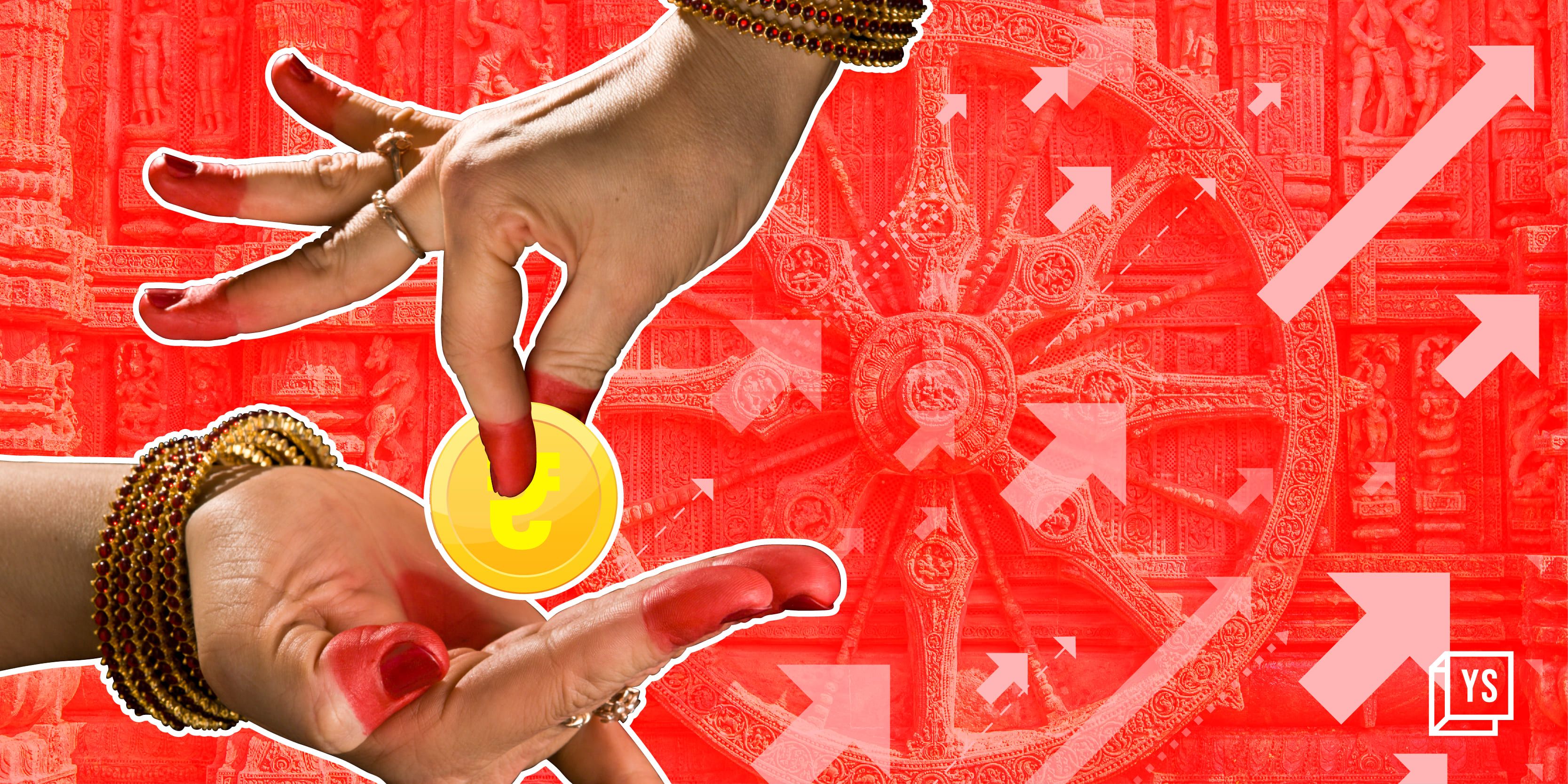
- Odisha aims to be among the top three startup destinations in India, with Chief Minister Naveen Patnaik envisioning the growth of at least 5,000 startups by 2025.
- The startup boom is not limited to major cities; emerging ventures are thriving across the state, including in places like Rourkela, Balasore, Berhampur, Sambalpur, and Bargarh.
- Startup Odisha has nurtured over 1,800 startups, emphasising strategic partnerships, supportive ecosystems, investments, and effective policies.
- A new startup policy is under consideration, aligning with global best practices, focusing on ESG factors, and promoting women’s entrepreneurship.
” data-brand=”yourstory” contenteditable=”false” data-clicktext=”” data-clickurl=”” data-pageurl=”https://yourstory.com/2024/01/odisha-startup-ecosystem-omkar-rai-naveen-patnaik” data-sectiontype=”Key Takeaways” data-emailid=”ishan.p@yourstory.com”>
font-size: 1rem;
padding-bottom: 1.1rem;
color: #171B1C;
width: auto !important;
padding: 1.5rem 0.875rem;
margin: 1rem 0rem !important;
background: #FFFEF5;
box-shadow: 0px 4px 24px rgba(130, 150, 165, 0.25);
height: 100%;
display: block;
position: relative;
max-width: unset;
.keyTakeAWaysContainer li, .keyTakeAWaysContainer p
font-family: Adobe Caslon Pro !important;
font-style: normal;
font-weight: 400 !important;
font-size: 21px !important;
line-height: 29px !important;
color: #0F171C !important;
.ql-editor .keyTakeAWaysTitlePara
font-family: Adobe Caslon Pro !important;
font-style: normal;
font-weight: 700 !important;
font-size: 20px !important;
color: #FFFFFF !important;
margin: 0 !important;
text-align: center;
line-height: 20px !important;
.keyTakeAWaysTitlePara
font-family: Adobe Caslon Pro !important;
font-style: normal;
font-weight: 700 !important;
font-size: 22px !important;
color: #FFFFFF !important;
margin: 0 !important;
text-align: center;
line-height: 20px !important;
margin-top: 5px !important;
.keyTakeAWaysWrapper
position: relative;
margin: 6% 0px;
.ql-editor .keyTakeAWays
margin: 1rem !important;
.keyTakeAWays
margin: 3rem 1rem !important;
.keyTakeAWays ol li:before
counter-increment: headings;
content: counter(headings) ”;
.ql-editor .keyTakeAWays ol li
padding-top: 2rem;
list-style-position:outside;
list-style-type: none;
.ql-editor .keyTakeAWays ul li
padding-top: 2rem;
list-style-position:outside;
list-style-type: disc;
.keyTakeAWays ol li
padding-top: 2rem;
list-style-position:outside;
list-style-type: none;
.keyTakeAWays ul li
padding-top: 2rem;
list-style-position:outside;
list-style-type: disc;
.keyTakeAWays ol li
padding-top: 2rem;
list-style-position:outside;
list-style-type: none;
display: table;
.keyTakeAWays ul li
padding-top: 2rem;
list-style-position:outside;
list-style-type: disc;
.keyTakeAWays ol li:not(.ql-direction-rtl), .keyTakeAWays ul li:not(.ql-direction-rtl)
padding-left: 0 !important;
.ql-editor .keyTakeAWays li::before,
.ql-editor .keyTakeAWays li::marker
width: 12px;
height: 24px;
font-family: Adobe Caslon Pro !important;
font-style: normal;
font-weight: 400;
font-size: 21px;
line-height: 24px;
color: #0F171C;
padding-right: 0em;
vertical-align: middle !important;
.keyTakeAWays li::before,
.keyTakeAWays li::marker
width: 12px;
height: 24px;
font-family: Adobe Caslon Pro !important;
font-style: normal;
font-weight: 400;
font-size: 21px;
line-height: 24px;
color: #0F171C;
padding-right: 0em;
vertical-align: middle !important;
.keyTakeAWays li::marker
unicode-bidi: unset !important;
font-variant-numeric: unset !important;
text-transform: none;
text-indent: 0px !important;
text-align: unset !important;
text-align-last: unset !important;
vertical-align: middle !important;
.keyTakeAWays ul > li::before
display: inline-block;
white-space: nowrap;
width: unset;
.ql-editor .keyTakeAWays .inline_link
color: #0F171C !important;
border: 1px solid #0F171C;
padding: 2px 5px 0px !important;
text-decoration: none !important;
margin: 0px 3px 5px !important;
.keyTakeAWays .inline_link,
.keyTakeAWaysContainer > ol > li > .link,
.keyTakeAWaysContainer > ul > li > .link
color: #0F171C !important;
border: 1px solid #0F171C;
padding: 5px 5px 0px 5px !important;
text-decoration: none !important;
text-align: center !important;
display: inline-block !important;
margin: 0px 3px 5px !important;
font-weight: 0;
cursor: pointer !important;
.ql-editor .keyTakeAWays .inline_link,
.ql-editor .keyTakeAWaysContainer > ol > li > .link,
.ql-editor .keyTakeAWaysContainer > ul > li > .link
color: #0F171C !important;
border: 1px solid #0F171C;
padding: 5px 5px 0px 5px !important;
text-decoration: none !important;
text-align: end !important;
display: inline-block !important;
margin: 0px 3px 5px !important;
cursor: pointer !important;
.keyTakeAWays u
border-bottom: 1px solid #0F171C;
text-decoration: none !important;
padding-bottom: 0px !important;
display: inline-block !important;
width: auto !important;
.keyTakeAWays .keyTakeAWaysPointsWrapper
margin: unset !important;
.keyTakeAWaysContainer p:is(:first-child)
margin: 4% 1% 3% 5.5%;
.keyTakeAWaysContainer p:not(:first-child)
margin: 4% 1% 3% 5.5%;
.keyTakeAWaysContainer p:last-child:has(br:only-child)
margin: 0 !important;
.keyTakeAWaysContainer p:is(:first-child) .keyTakeAWaysTitleWrapper
top: -1rem;
.keyTakeAWays .company-widget
font-size: 20px !important;
color: #000000 !important;
cursor: pointer !important;
font-weight: 600 !important;
font-family: Adobe Caslon Pro !important;
display: unset !important;
.ql-editor .keyTakeAWays .company-widget::after,
.keyTakeAWays .company-widget::after
font-family: pt-sans !important;
content: ‘i’;
font-size: 12px !important;
border-radius: 20px !important;
border: 2.6px solid #000000 !important;
color: #000000 !important;
transform: translateY(-24%) !important;
line-height: 14px !important;
display: inline-block !important;
height: 17px !important;
width: 17px !important;
margin: 0px 0.2rem !important;
text-align: center !important;
font-weight: 900;
padding-top: 2px;
.ql-editor .keyTakeAWaysTitleWrapper
height: 37px;
width: 181px;
display: flex;
align-items: center;
background: black;
justify-content: center;
position: absolute;
top: -1rem;
left: 6%;
.keyTakeAWaysTitleWrapper
height: 37px;
width: 210px;
display: flex;
align-items: center;
background: black;
justify-content: center;
position: absolute;
top: -1rem;
left: 6%;
.ql-editor .keyTakeAWays ul
counter-reset: headings;
.keyTakeAWays ul
counter-reset: headings;
.ql-editor .keyTakeAWays ol
counter-reset: headings;
.keyTakeAWays ol
counter-reset: headings;
.keyTakeAWays ol
margin: 0 !important;
padding: 0 !important;
.ql-editor .keyTakeAWays ul, .ql-editor .keyTakeAWays ol
margin: 0px 0px 0px 0.8rem !important;
padding: 0 !important;
border-collapse: separate;
border-spacing: 1.5rem;
.keyTakeAWays ul
margin: 0px 0px 0px 0.8rem !important;
padding: 0 !important;
border-collapse: separate;
border-spacing: 1rem 2rem;
.keyTakeAWays ol
margin: 0px 0px 0px 0.5rem !important;
padding: 0 !important;
border-collapse: separate;
border-spacing: 1rem 2rem;
.ql-editor .keyTakeAWays ol, .ql-editor .keyTakeAWays ol
padding: 0 !important;
border-collapse: separate;
border-spacing: 1.5rem;
.keyTakeAWays ol
display: table !important;
.keyTakeAWays ul
display: table !important;
.keyTakeAWays ol li
list-style: none !important;
display: table-row !important;
.keyTakeAWays ul li
list-style: none !important;
display: table-row !important;
text-indent: unset !important;
.keyTakeAWays ol li::before
display: table-cell !important;
text-align: right !important;
vertical-align: middle !important;
.keyTakeAWays ul li::before
display: table-cell !important;
text-align: right !important;
padding-right: 0rem !important;
content: “\2022” !important;
vertical-align: middle !important;
.ql-editor .keyTakeAWays ul li:not(.ql-direction-rtl)::before
margin: 0px !important;
@media (max-width: 769px)
.keyTakeAWaysContainer p:is(:first-child)
margin: 13% 1% 3% 5.5% !important;
.keyTakeAWaysContainer p:not(:first-child)
margin: 4% 1% 3% 5.5% !important;
.keyTakeAWays ul, .keyTakeAWays ol
margin: 0px !important;
.keyTakeAWays .inline_link,
.keyTakeAWaysContainer > ol > li > .link,
.keyTakeAWaysContainer > ul > li > .link
text-align: center !important;
.keyTakeAWaysTitleWrapper
width: 155px;
height: 30px;
top: -1rem;
left: 12.5%;
.ql-editor .keyTakeAWaysTitlePara
font-family: Adobe Caslon Pro !important;
font-style: normal;
font-weight: 400 !important;
font-size: 16px !important;
.keyTakeAWaysTitlePara
font-family: Adobe Caslon Pro !important;
font-style: normal;
font-weight: 400 !important;
font-size: 16px !important;
margin-top: 5px !important;
.keyTakeAWaysContainer
margin: 1% 0px 0rem 0px !important;
.keyTakeAWaysContainer li, .keyTakeAWaysContainer p
font-family: Adobe Caslon Pro !important;
font-style: normal;
font-weight: 400 !important;
font-size: 17px !important;
line-height: 24px !important;
.keyTakeAWays li::before,
.keyTakeAWays li::marker
width: 5px;
height: 24px;
font-family: Adobe Caslon Pro !important;
font-weight: 500;
font-size: 14px !important;
line-height: 24px;
color: #0F171C;
padding-right: 0em;
.keyTakeAWays ul > li::before
width: unset !important;
font-size: 18px !important;
.keyTakeAWaysPointsWrapper
box-shadow: 0px 4px 24px rgba(170, 167, 162, 0.38);
padding: 0.8rem 0.5rem 1rem !important;
.ql-editor .keyTakeAWays ol > li
padding-top: 1rem;
list-style-type: none;
list-style-position: inside;
.keyTakeAWays ol > li
padding-top: 1rem;
list-style-type: none;
list-style-position: outside;
.ql-editor .keyTakeAWays ul > li
padding-top: 1rem;
list-style-type: disc;
list-style-position: inside;
text-indent: -6% !important;
margin-left: 1em !important;
.keyTakeAWays ul > li
padding-top: 1rem;
list-style-type: disc;
list-style-position: inside;
.keyTakeAWays
margin: 2rem 1rem 3.5rem !important;
// 2rem 1rem 3.5rem !important;
.keyTakeAWaysContainer p
margin: 4% 4% 0 8% !important;
.keyTakeAWaysContainer p:last-child:has(br:only-child)
margin: 0 !important;
.ql-editor .keyTakeAWays .company-widget::after,
.keyTakeAWays .company-widget::after
height: 0.8rem !important;
width: 0.7rem !important;
.ql-editor .keyTakeAWays .company-widget,
.keyTakeAWays .company-widget
font-size: 1.12rem !important;
line-height: 0.9rem !important;
.keyTakeAWays li::before, .keyTakeAWays li::marker
padding: 0px !important;
@media (max-width: 300px)
.keyTakeAWaysTitleWrapper
left: 18% !important;
top: -1rem !important;
.keyTakeAWaysContainer p:is(:first-child)
margin: 14% 1% 3% 4.5% !important;
.keyTakeAWaysContainer p:not(:first-child)
margin: 4% 1% 3% 4.5% !important;
@media (min-width: 200px) and (max-width: 389px)
.keyTakeAWays ul > li::before
width: unset !important;
.keyTakeAWays ul > li
padding-top: 1rem;
list-style-type: disc;
list-style-position: inside;
@media (min-width: 500px) and (max-width: 600px)
.keyTakeAWaysTitleWrapper
left: 8% !important;
.keyTakeAWaysContainer p:is(:first-child)
margin: 8% 1% 3% 2.5% !important;
.keyTakeAWaysContainer p:not(:first-child)
margin: 4% 1% 3% 2.5% !important;
@media (min-width: 390px) and (max-width: 500px)
.keyTakeAWays ul li:not(.ql-direction-rtl)::before
margin-left: -1em !important;
margin-right: 0em !important;
.keyTakeAWaysContainer p:is(:first-child)
margin: 12.5% 1% 3% 5.5% !important;
.keyTakeAWaysContainer p:not(:first-child)
margin: 4% 1% 3% 5.5% !important;
@media (min-width: 768px) and (max-width: 820px)
.keyTakeAWays ul li:not(.ql-direction-rtl)::before
margin-left: -0.3em !important;
margin-right: 0em !important;
@media (max-width: 1280px)
.keyTakeAWaysTitlePara
margin-top: 5px !important;
@media (min-width: 768px) and (max-width: 768px)
.keyTakeAWaysTitleWrapper
left: 6% !important;
top: -1rem !important;
.keyTakeAWaysTitlePara
margin-top: 3px !important;
.keyTakeAWaysContainer p:is(:first-child)
margin: 8% 1% 3% 2.5% !important;
.keyTakeAWaysContainer p:not(:first-child)
margin: 4% 1% 3% 2.5% !important;
@media (min-width: 414px) and (max-width: 417px)
.keyTakeAWays ol
border-spacing: 1.6rem 2rem !important;
.keyTakeAWays ul
border-spacing: 1.2rem 2rem !important;
.glossary-story-scroll
text-decoration: none !important;
color: #000 !important;
cursor: pointer !important;
}
Key Takeaways
- Odisha aims to be among the top three startup destinations in India, with Chief Minister Naveen Patnaik envisioning the growth of at least 5,000 startups by 2025.
- The startup boom is not limited to major cities; emerging ventures are thriving across the state, including in places like Rourkela, Balasore, Berhampur, Sambalpur, and Bargarh.
- Startup Odisha has nurtured over 1,800 startups, emphasising strategic partnerships, supportive ecosystems, investments, and effective policies.
- A new startup policy is under consideration, aligning with global best practices, focusing on ESG factors, and promoting women’s entrepreneurship.
Nestled along the eastern coast of India, Odisha, with its rich cultural tapestry and diverse landscapes, is not only a land of ancient temples and pristine beaches but is now setting its sights on a bold, innovative future—aspiring to be among the top three startup destinations in the country.
“Odisha Chief Minister Naveen Patnaik envisions our state emerging as one of the top three startup destinations in the country, aiming to foster at least 5,000 startups by 2025,” says Dr Omkar Rai, Executive Chairman of Startup Odisha, in an exclusive conversation with YourStory.
While Bhubaneswar, Khurda, and Cuttack are witnessing a surge in startups, the entrepreneurial spirit extends across the entire state, with emerging ventures in places like Rourkela, Balasore, Berhampur, Sambalpur, Bargarh, and beyond.
Some notable startups from Bhubaneswar include Milk Mantra in dairy foods, Villa Mart in agri, and emerging firms like CureBay, EzeRx, and MedTel in the larger healthcare space. The drone sector features companies like IG Drones and Darubrahma, while Innocule excels in speciality chemicals, iServeU in fintech, LectureNotes in education, and Bookingjini in hospitality.
The role of Startup Odisha in nurturing companies can not be overstated. It has fostered over 1,800 startups across sectors such as agritech, IT, artificial intelligence, healthcare, fintech, and biotechnology.
Its achievement is attributed to strategic partnerships, a supportive ecosystem, investments, and effective policy interventions.
In 2016, the Odisha Startup Policy laid the foundation for Startup Odisha, operating under the MSME Dept., Govt. of Odisha, as the nodal agency for developing the state’s startup and innovation ecosystem.
“The policy was created in 2016 and was subsequently amended in 2018. Currently, a new policy is under government consideration,” Dr Rai says, adding that five years have elapsed, and the startup ecosystem has undergone significant changes.
The Startup Odisha chief explains that the new policy, informed by global best practices and shaped by The Department for Promotion of Industry and Internal Trade’s States Startup Ranking framework, strives to align with evolving trends.
It places a greater emphasis on Environmental, Social, and Governance (ESG) factors, emphasising sustainable and green technologies. Furthermore, the policy intensifies its focus on onboarding and promoting women’s entrepreneurship.
The new policy draft is currently being shared with the Odisha Government, with ongoing work, and it is anticipated to roll out in the first quarter of 2024, says Dr Rai.
<figure class="image embed" contenteditable="false" data-id="535380" data-url="https://images.yourstory.com/cs/2/d99b1110116911ed9e63f54395117598/OdishaStartupHubV2Graphic1-1705318609977.jpg" data-alt="Startup Odisha" data-caption="
Infographic design credit: Nihar Apte.
” align=”center”> Infographic design credit: Nihar Apte.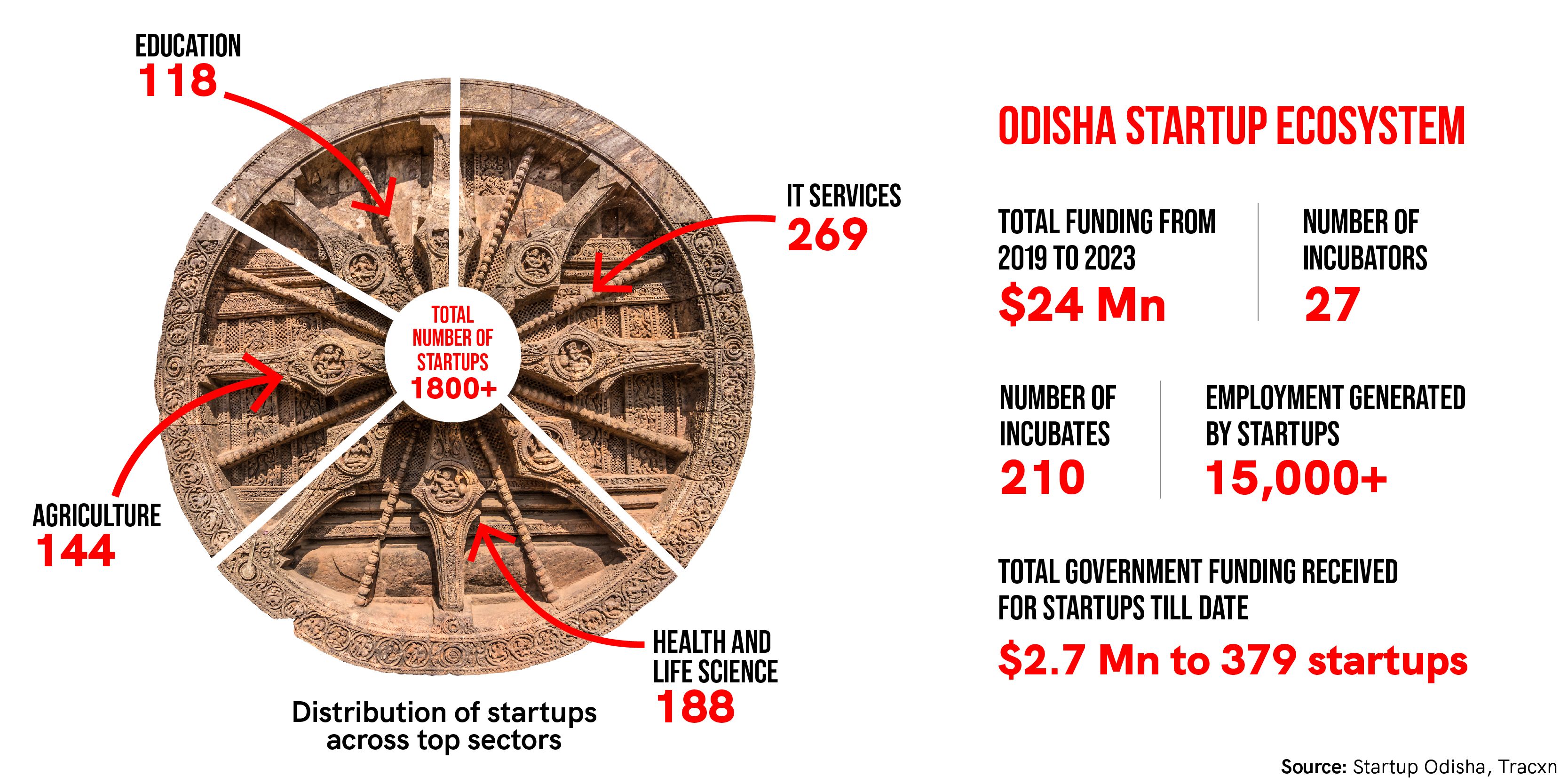
Conducive ecosystem
According to Dr Rai, Odisha is focusing on creating incubators to ensure startups get funding as well as market access.
The state hosts 27 incubators, and among them is Odisha Startup Hub (O-Hub), the Government of Odisha’s incubator, featuring an expansive four lakh sq ft space—one of the largest incubators in the entire country.
O-Hub, wholly owned and operated by the State Government, is equipped with state-of-the-art plug-and-play infrastructure to facilitate startup incubation.
At any given time, O-Hub can accommodate nearly 400 startups, Dr Rai says, adding that the space features various centres of excellence, common areas, exhibition spaces, demonstration areas, a Fab Lab, co-working spaces, and dedicated spaces for ecosystem enablers—stakeholders such as mentors, investors, venture capitalists, and others.
It is designed to serve as a central hub for startup activities across the entire state, with other incubators and entities acting as spokes, he remarks. At present, there are 75 active Entrepreneurship Cells (E-cells) and 93 incubates.
The new policy will also enable to increase the number of incubators across the state. Every district will have at least one incubator and educational institutions will be supported to establish their own, Dr Rai says.
Additionally, there will be incentives and policy support to encourage corporate entities to establish incubators.
In September 2023, the state launched two initiatives—Startup Yatra for university and college students, and Startup Xpress for school students. Both programmes were designed to inform and guide young boys and girls about available benefits, the existing ecosystem, policies, programmes, and incentives from both state and central governments.
The Startup Yatra and Express included 254 van camps across 30 districts engaging students from over 250 educational institutions, and gathering innovative ideas. It had 47 boot camps with training on entrepreneurship, ideation, business models, and pitching skills.
Fifty selected participants were then offered a three-day acceleration programme, which provided mentorship and resources. The top 20 ideas proceeded to O-Hub for a demo day, where participants presented their business ideas to judges. The top 10 winners received seed funding of Rs 3 lakh each to develop their ideas into viable businesses.
According to Dr Rai, more than 33,000 students took part in the boot camps across the state, resulting in the generation of over 3,700 ideas.
In addition, Startup Odisha, partnering with MIT Fab Foundation, plans to establish a Super Fab Lab in O-Hub’s Tower B, serving as the central infrastructure for the upcoming Odisha State Fab Network, connecting all state-wide Fab Labs.
Teaming up with MIT Fab Foundation will place Odisha on the global Fab infrastructure map, nurturing a worldwide community of makers and enabling cross-border exchange of knowledge, resources, and wealth in the maker and fab world, according to Dr Rai.
The MIT Fab Lab will house a Fab Academy, providing training for users and facilitators of Fab and related infrastructure in the state. This initiative aims to cultivate a skilled workforce for local startups and incubators.
<figure class="image embed" contenteditable="false" data-id="535381" data-url="https://images.yourstory.com/cs/2/d99b1110116911ed9e63f54395117598/OdishaStartupHubV2Graphic3-1705318699656.jpg" data-alt="Startups in Odisha" data-caption="
Infographic design credit: Nihar Apte.
” align=”center”> Infographic design credit: Nihar Apte.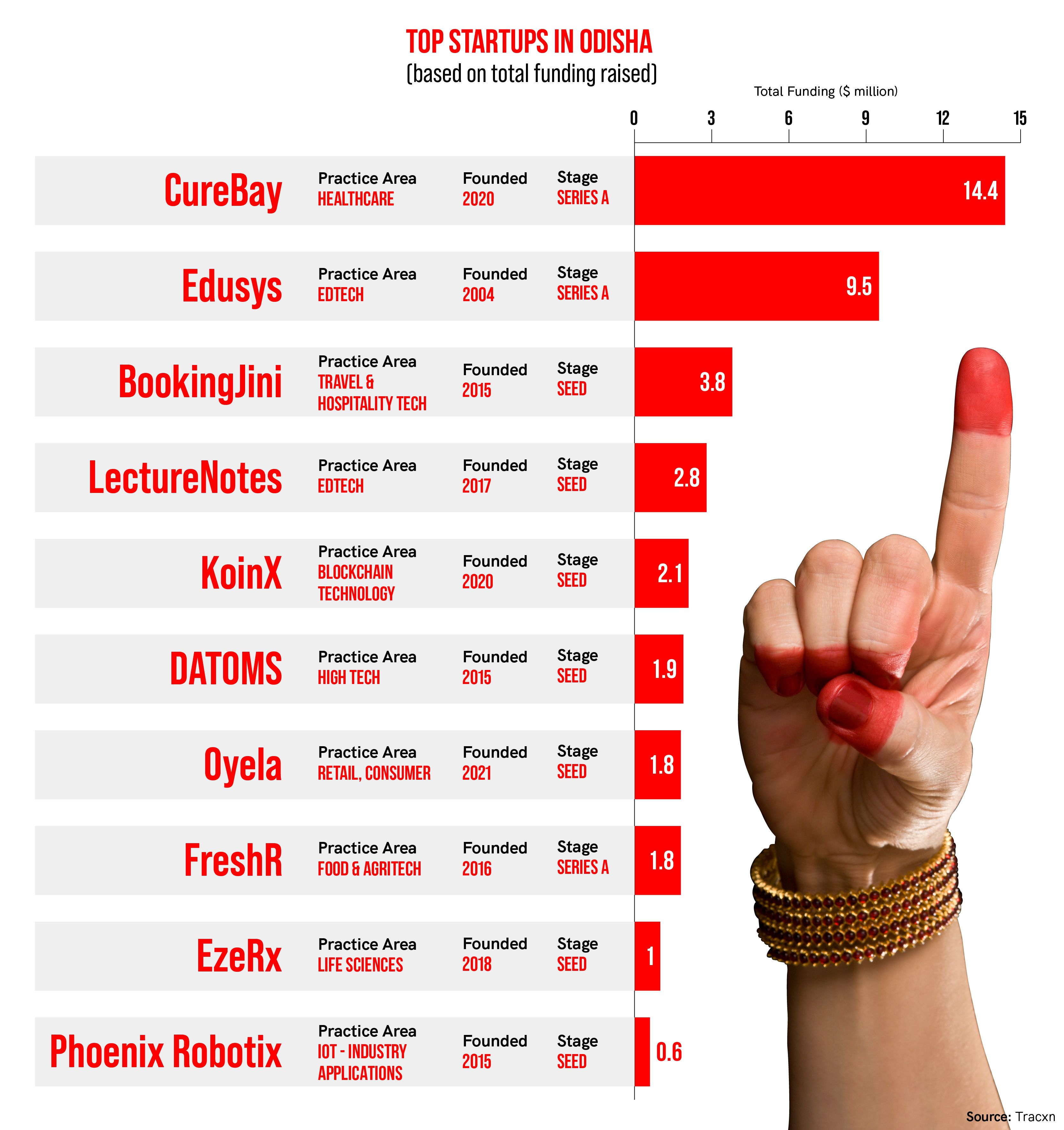
Funding opportunities
“Our startup ecosystem has attracted nearly Rs 370 crore in external investments, in addition to the grants and incentives provided by Startup Odisha,” Dr Rai says.
Startup Odisha has also launched a Rs 100 crore Odisha Startup Growth Fund (Fund of Funds), with the Small Industries Development Bank of India (SIDBI) as the fund manager. The state government will consistently replenish the fund to ensure continuous and long-term support for startups after the initial corpus of Rs 100 crore gets exhausted.
“We have collaborated with SIDBI, securing a 10 crore seed funding that will be made accessible to startups incubated in O-HUB. Additionally, some of our incubators have received support from Atal Innovation Mission, DST (Department of Science & Technology), and MSME — Government of India,” Dr Rai notes.
Eight incubators from the state have received the Startup India Seed Fund. A total of 140 startups have been seed-funded, and 21 startups have secured venture funding.
Under startup incentives, recognised startups can apply for monetary benefits available under the Startup Odisha initiative, including monthly allowance, product development and marketing/publicity assistance, need-based support, financial support for event participation, and subsidised incubation. There are additional benefits for women-led startups.
“These funding opportunities will not only benefit our existing startups but also gravitate startups from other parts of the country to Odisha. The easy availability of funds and market access within the state will attract them,” the Startup Odisha chief explains.
<figure class="image embed" contenteditable="false" data-id="535382" data-url="https://images.yourstory.com/cs/2/d99b1110116911ed9e63f54395117598/OdishaStartupHubV2Graphic2-1705318765453.jpg" data-alt="Investors in Odisha" data-caption="
Infographic design credit: Nihar Apte.
” align=”center”> Infographic design credit: Nihar Apte.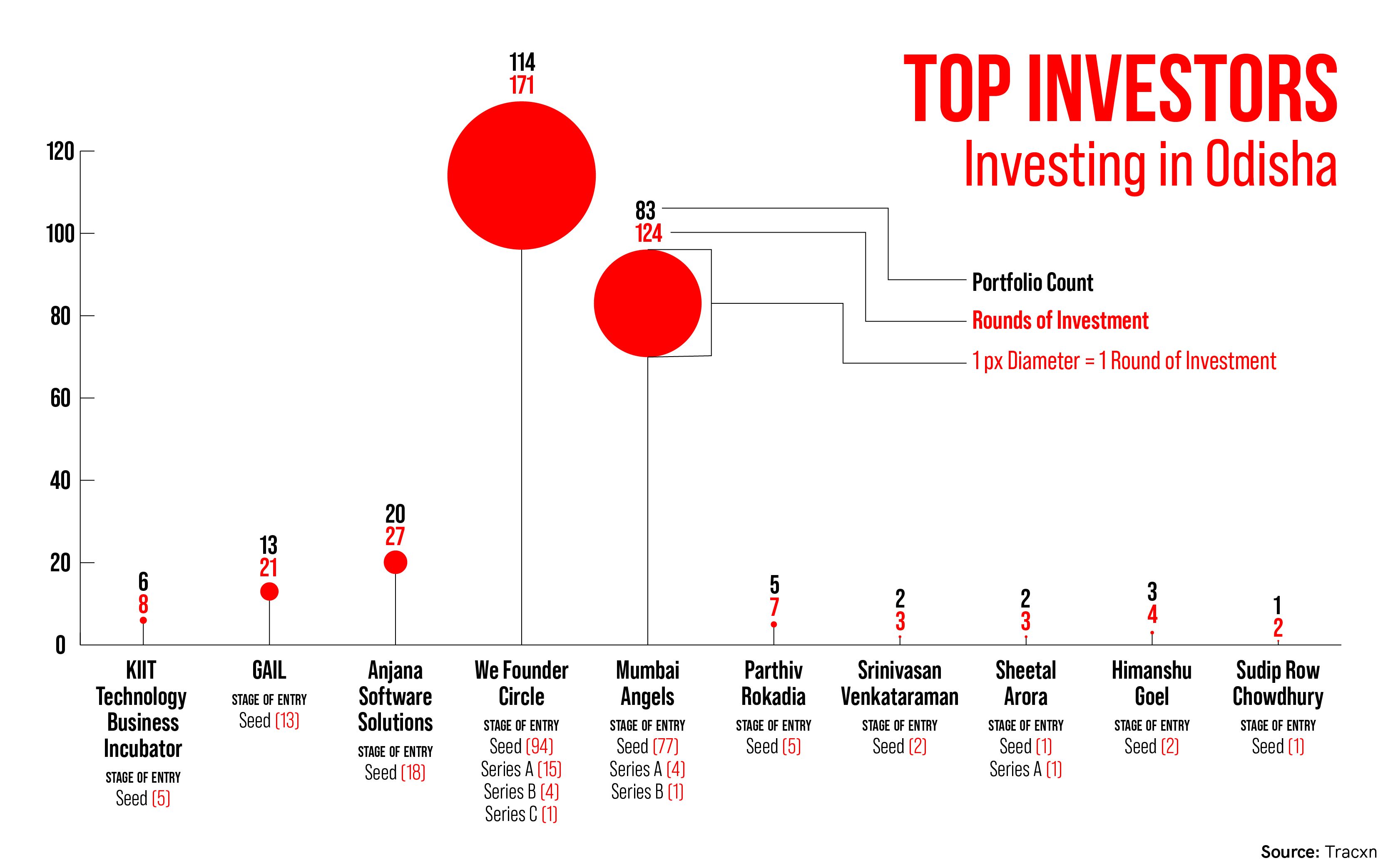
Challenges and opportunities
When discussing more mature startup ecosystems in the country such as Bengaluru, Pune, Chennai, Hyderabad, NCR, and others, he says that they thrive on the abundant talent available, particularly owing to India’s IT industry. These locations attract numerous mentors, investors, and ideas, collectively driving the entire ecosystem.
“The entire startup ecosystem and entrepreneurial landscape in those states or locations are led and driven by their industries. However, this dynamic does not apply to our state, as the critical mass of industry has not reached that level. Therefore, the state government has to take the initiative and play the role that the industry plays in those places,” Dr Rai elaborates.
“We are not in direct competition with those places. However, when it comes to our policies and initiatives, we adopt a very aggressive approach,” he adds.
Playing to one’s strengths is a good approach to take. One of Odisha’s strengths lies in agriculture, especially in producing specific agricultural items. Therefore, the state must excel in fisheries, seafood, and food processing, according to Dr Rai.
“The sports sector holds significant potential in our state, given the government of Odisha’s decade-long promotion of sports, resulting in the development of substantial infrastructure and a thriving ecosystem. Now, the primary focus of Startup Odisha is to enhance and expand beyond the existing facilities and infrastructure within the sports sector,” Dr Rai shares.
In sports, the potential for innovation is ample, particularly in areas like sports medicine, fitness, sports analytics, and sports nutrition, where a surge of startups is essential, he adds.
Looking at the larger picture—startups drive innovation through entrepreneurship, generating revenue, creating employment, and facilitating the growth of industries and their customers, contributing to the overall GDP and fostering prosperity in the state.
“All the initiatives we are undertaking, including the new policy and the infrastructure support we are striving to create, are part of a comprehensive strategy. The measures, incentives, and initiatives embedded in our policy, along with current actions, are aimed at positioning Odisha as a prominent and leading startup destination,” he remarks.
(Cover image and infographics designed by Nihar Apte)
Edited by Affirunisa Kankudti

